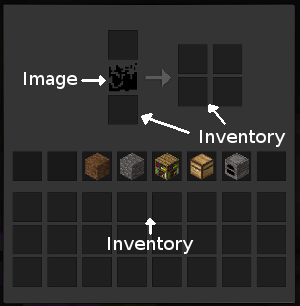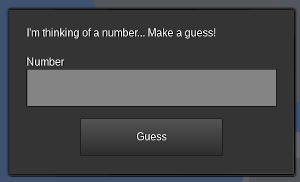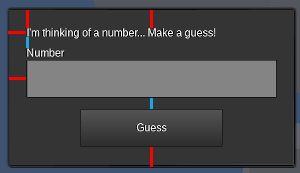GUIs (Formspecs)
Introduction

In this chapter we will learn how to create a formspec and display it to the user. A formspec is the specification code for a form. In Minetest, forms are windows such as the player inventory and can contain a variety of elements, such as labels, buttons and fields.
Note that if you do not need to get user input, for example when you only need to provide information to the player, you should consider using Heads Up Display (HUD) elements instead of forms, because unexpected windows tend to disrupt gameplay.
Real or Legacy Coordinates
In older versions of Minetest, formspecs were inconsistent. The way that different elements were positioned varied in unexpected ways; it was hard to predict the placement of elements and align them. Minetest 5.1.0 contains a feature called real coordinates which aims to rectify this by introducing a consistent coordinate system. The use of real coordinates is highly recommended, and so this chapter will use them exclusively.
Using a formspec_version of 2 or above will enable real coordinates.
Anatomy of a Formspec
Elements
Formspec is a domain-specific language with an unusual format. It consists of a number of elements with the following form:
type[param1;param2]
The element type is declared and then any parameters are given in square brackets. Multiple elements can be joined together, or placed on multiple lines, like so:
foo[param1]bar[param1]
bo[param1]
Elements are items such as text boxes or buttons, or can be metadata such as size or background. You should refer to lua_api.md for a list of all possible elements.
Header
The header of a formspec contains information which must appear first. This includes the size of the formspec, the position, the anchor, and whether the game-wide theme should be applied.
The elements in the header must be defined in a specific order, otherwise you will see an error. This order is given in the above paragraph, and, as always, documented in the Lua API reference.
The size is in formspec slots - a unit of measurement which is roughly around 64 pixels, but varies based on the screen density and scaling settings of the client. Here’s a formspec which is 2,2 in size:
formspec_version[4]
size[2,2]
Notice how we explicitly defined the formspec language version. Without this, the legacy system will instead be used instead - which will prevent the use of consistent element positioning and other new features.
The position and anchor elements are used to place the formspec on the screen. The position sets where on the screen the formspec will be, and defaults to the center (0.5,0.5). The anchor sets where on the formspec the position is, allowing you to line the formspec up with the edge of the screen. The formspec can be placed to the left of the screen like so:
formspec_version[4]
size[2,2]
position[0,0.5]
anchor[0,0.5]
This sets the anchor to the left middle edge of the formspec box, and then the position of that anchor to the left of the screen.
Guessing Game

The best way to learn is to make something, so let’s make a guessing game. The principle is simple: the mod decides on a number, then the player makes guesses on the number. The mod then says if the guess is higher or lower then the actual number.
First, let’s make a function to create the formspec code. It’s good practice to do this, as it makes it easier to reuse elsewhere.
guessing = {}
function guessing.get_formspec(name)
-- TODO: display whether the last guess was higher or lower
local text = "I'm thinking of a number... Make a guess!"
local formspec = {
"formspec_version[4]",
"size[6,3.476]",
"label[0.375,0.5;", minetest.formspec_escape(text), "]",
"field[0.375,1.25;5.25,0.8;number;Number;]",
"button[1.5,2.3;3,0.8;guess;Guess]"
}
-- table.concat is faster than string concatenation - `..`
return table.concat(formspec, "")
end
In the above code, we place a field, a label, and a button. A field allows text entry, and a button is used to submit the form. You’ll notice that the elements are positioned carefully in order to add padding and spacing, this will be explained later.
Next, we want to allow the player to show the formspec. The main way to do this is using show_formspec:
function guessing.show_to(name)
minetest.show_formspec(name, "guessing:game", guessing.get_formspec(name))
end
minetest.register_chatcommand("game", {
func = function(name)
guessing.show_to(name)
end,
})
The show_formspec function accepts a player name, the formspec name, and the formspec itself. The formspec name should be a valid itemname, ie: in the format modname:itemname.
Padding and Spacing

Padding is the gap between the edge of the formspec and its contents, or between unrelated elements, shown in red. Spacing is the gap between related elements, shown in blue.
It is fairly standard to have a padding of 0.375 and a spacing of 0.25.
Receiving Formspec Submissions
When show_formspec is called, the formspec is sent to the client to be displayed. For formspecs to be useful, information needs to be returned from the client to server. The method for this is called formspec field submission, and for show_formspec, that submission is received using a global callback:
minetest.register_on_player_receive_fields(function(player, formname, fields)
if formname ~= "guessing:game" then
return
end
if fields.guess then
local pname = player:get_player_name()
minetest.chat_send_all(pname .. " guessed " .. fields.number)
end
end)
The function given in minetest.register_on_player_receive_fields is called every time a user submits a form. Most callbacks will need to check the formname given to the function, and exit if it is not the right form; however, some callbacks may need to work on multiple forms, or on all forms.
The fields parameter to the function is a table of the values submitted by the user, indexed by strings. Named elements will appear in the field under their own name, depending on the event. Some elements will only be submitted if they caused the event, such as buttons, and some elements will always appear in submissions, such as fields.
Malicious clients can submit anything at anytime
You should never trust a formspec submission. A malicious client can submit anything they like at any time - even if you never showed them the formspec. This means that you should check privileges and make sure that they should be allowed to perform the action.
So, now the formspec is sent to the client and the client sends information back. The next step is to somehow generate and remember the target value, and to update the formspec based on guesses. The way to do this is using a concept called “contexts”.
Contexts
In many cases you want minetest.show_formspec to give information to the callback which you don’t want to send to the client. This might include what a chat command was called with, or what the dialog is about. In this case, the target value that needs to be remembered.
A context is a per-player table to store information, and the contexts for all online players are stored in a file-local variable:
local _contexts = {}
local function get_context(name)
local context = _contexts[name] or {}
_contexts[name] = context
return context
end
minetest.register_on_leaveplayer(function(player)
_contexts[player:get_player_name()] = nil
end)
Next, we need to modify the show code to update the context before showing the formspec:
function guessing.show_to(name)
local context = get_context(name)
context.target = context.target or math.random(1, 10)
local fs = guessing.get_formspec(name, context)
minetest.show_formspec(name, "guessing:game", fs)
end
We also need to modify the formspec generation code to use the context:
function guessing.get_formspec(name, context)
local text
if not context.guess then
text = "I'm thinking of a number... Make a guess!"
elseif context.guess == context.target then
text = "Hurray, you got it!"
elseif context.guess > context.target then
text = "Too high!"
else
text = "Too low!"
end
Note that it’s good practice for get_formspec to only read the context, and not update it at all. This can make the function simpler, and also easier to test.
And finally, we need to update the handler to update the context with the guess:
if fields.guess then
local name = player:get_player_name()
local context = get_context(name)
context.guess = tonumber(fields.number)
guessing.show_to(name)
end
Formspec Sources
There are three different ways that a formspec can be delivered to the client:
- show_formspec: the method used above, fields are received by
register_on_player_receive_fields. - Node Meta Formspecs: the node contains a formspec in its meta data, and the client shows it immediately when the player rightclicks. Fields are received by a method in the node definition called
on_receive_fields. - Player Inventory Formspecs: the formspec is sent to the client at some point, and then shown immediately when the player presses
i. Fields are received byregister_on_player_receive_fields.
Node Meta Formspecs
minetest.show_formspec is not the only way to show a formspec; you can also add formspecs to a node’s metadata. For example, this is used with chests to allow for faster opening times - you don’t need to wait for the server to send the player the chest formspec.
minetest.register_node("mymod:rightclick", {
description = "Rightclick me!",
tiles = {"mymod_rightclick.png"},
groups = {cracky = 1},
after_place_node = function(pos, placer)
-- This function is run when the chest node is placed.
-- The following code sets the formspec for chest.
-- Meta is a way of storing data onto a node.
local meta = minetest.get_meta(pos)
meta:set_string("formspec",
"formspec_version[4]" ..
"size[5,5]" ..
"label[1,1;This is shown on right click]" ..
"field[1,2;2,1;x;x;]")
end,
on_receive_fields = function(pos, formname, fields, player)
if fields.quit then
return
end
print(fields.x)
end
})
Formspecs set this way do not trigger the same callback. In order to receive form input for meta formspecs, you must include an on_receive_fields entry when registering the node.
This style of callback triggers when you press enter in a field, which is impossible with minetest.show_formspec; however, this kind of form can only be shown by right-clicking on a node. It cannot be triggered programmatically.
Player Inventory Formspecs
The player inventory formspec is the one shown when the player presses i. The global callback is used to receive events from this formspec, and the formname is "".
There are a number of different mods which allow multiple mods to customise the player inventory. Minetest Game uses SFINV.
Your Turn
- Extend the Guessing Game to keep track of each player’s top score, where the top score is how many guesses it took.
- Make a node called “Inbox” where users can open up a formspec and leave messages. This node should store the placers’ name as
ownerin the meta, and should useshow_formspecto show different formspecs to different players.